October 22, 2016
Reading Conflict on the Walls of Buenos Aires [Part 1]
Written by George Kafka
The twentieth century history of Buenos Aires can be read through its public spaces. Starting in La Boca, ‘El Caminito’, an open air museum, portrays the streets that Italian immigrants inhabited with the wave of immigration in the early decades of the century. A short bus ride up to Avenida 9 de Julio will bring you face to face with Evita’s affectionate smile, gleaming from the very building where she addressed the ‘descamisados’. Head a few blocks downtown and you find yourself at Plaza de Mayo, the site of the legendary acts of protest in the face of brutal dictatorship by the mothers and grandmothers of the ‘desaparecidos’, as well as a permanent occupation of the plaza demanding rights for the veterans of the Falklands War. A large metal barricade separates these two spaces, the legacy of fierce riots that shook the city following economic collapse in 2001. These, and countless other examples, are emblematic of the importance of public space in the life of porteños.

Nowhere is this public nature of social and political life made more apparent than on the very walls that form the built environment of the city. Of the 12,255 blocks that make up the legislated city of Buenos Aires (known as Capital Federal), it is virtually impossible to find one that is untouched by tags, murals, political slogans, advertisements, personal messages, official signage and various other forms of visual communication. Thus, to observe the walls of the city is to observe the life of the city itself. Upon these architectural forms, one can read artistic expression, personal despair, individualistic bravado, neighbourhood rivalries, political anger, capitalistic ambition and a multitude of other messages, direct and indirect, revealing the life of the individuals and institutions that make and live the city.
Crucially, while scholars such as Richard Freeman and Flavio Janches have considered the production of social and political meanings by public spaces in Buenos Aires, there has been very little written on the specific use of graffiti, street art and other forms of urban media as a producer of meaning in the Argentinian capital. Similarly, critics such as Alison Young, Cedar Lewisohn, Luca M. Visconti, John F. Sherry Jr., Stefania Borghini and Laurel Anderson have written on the politics of street art and public space in various global cities, it seems that few writers have extended their analyses to consider the full range of urban media.
I would like to suggest that one can learn as much from the full range of urban media, and specifically the relationship between them, as from looking at street art alone. It is with this in mind that I intend to read the full range of urban media as indicators of social, political and commercial conflicts over public space, citizenship and democracy. These conflicts can be referred to as ‘locational conflicts’, defined by Don Mitchell as ‘conflict over the legitimacy of various uses of space, and thus of various strategies for asserting rights…’
Further, as Henri Lefebvre points out in The Production of Space, ‘the fact remains…that an already produced space can be decoded, can be read.’
This essay will therefore attempt to ‘read’ the walls of Buenos Aires as a part of the public space of the city which can be used to draw conclusions about ideas of urban space, citizenship and democracy. By analysing the social, political and commercial conflicts that can be observed on the walls of the city, this essay will demonstrate the role that urban media play as a mirror to the social and political life of the city.
The first section of the essay will focus on a specific crossroad in the neighbourhood of Chacarita that contains an interesting range of urban media that demonstrate typical examples of conflict between different social groups. This section will consider the interaction between different pieces and the implication of this in a wider social context, in line with Sharon Zukin’s idea of ‘call and response between different social groups’ that is a part of the ‘landscape and vernacular’ of a city.
The second section will look at commercial conflict, namely the locational conflict that occurs between advertisements and artists who compete for the attention of the city dweller. This section will also analyse the use of the visual language of street art and graffiti by corporations as a marketing technique.
The final section of the essay will look at conflict in a political context, focussing on the use of graffiti techniques as a way of bringing political conflicts into the public spaces of the city. Furthermore, this section will consider the use of urban media as a form of remembering the political crises of 2001.
It seems important at this stage to clarify what is meant by the term ‘urban media’. In this essay the term will be used to refer to the full range of markings which can be found on the walls of the city. These include: graffiti, unique examples of communication via the city walls such as personal messages to a friend or lover, or a slur relating to a football team; tags, the repeated painting of a pseudonym on the city walls, usually with a focus on calligraphy and typography; murals, usually larger scale pieces with more pictorial content such as human forms; stencils, an image or phrase which is repeated in a similar fashion to tagging with the use of a stencil template; advertisements, specifically those which are pasted on the walls of the city at street level or painted in the style of stencils; street signs, official signage indicating street names or similar information; political propaganda, slogans which appear across Buenos Aires with repeated fonts and colours, usually applied by youth activist groups such as La Cámpora.
The primary source of material for this essay comes from my own observations of the city and its urban media. I would like to suggest that this is the only way to attempt to analyse the full range of urban media owing to the constant state of flux in which the city exists. My research is, therefore, limited to the spaces which I was able to cover and so clearly does not encompass the whole city. The majority of the research took place in the neighbourhoods of Chacarita, Colegiales, Almagro and Villa Crespo. Despite the limitations of this research, the specific examples in this essay serve as archetypal cases which reflect wider trends in the urban media of the city. All of the images included were taken by me, unless stated.
Social space and conflict
Nestled in the residential barrio of Chacarita at the crossing of Santos Dumont and General Juan G. Lemos streets, a typical crossroad in the expansive grid system of Buenos Aires, one can find an archetypal space of conflict. This is not an extraordinary part of the city, nor is it an extraordinary example of street art or other forms of urban media, but it serves as a fitting example to illuminate a number of conflicts that are fundamental for our understanding of the different forces that contend to, in David Harvey’s terms, ‘change [the city] after our heart’s desire.’
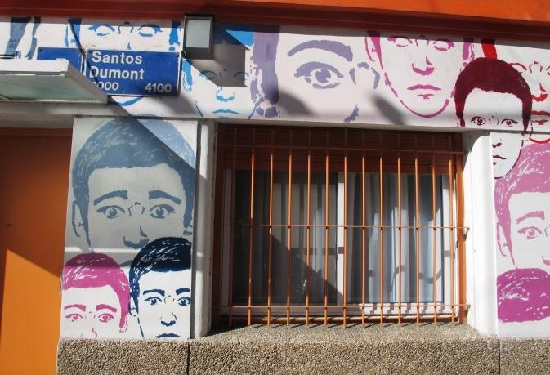
Approaching the corner from Corrientes Avenue, one is faces with four buildings that face into the crossroads in the centre. One building (No. 300, Gral Juan G. Lemos) is decorated with a series of stencils of a young man’s face by the bs. as. stencil collective. The stencils are repeated in different colours and sizes across the front of the building, forming something of a stencilled wallpaper (Fig. 1, see Appendix for all images). The young man’s face is characterised by a look of intense concern. Some of the larger copies of the stencil show only his eyes, revealing outright panic. Crucially, while the young man’s face is repeated, there are slight variations in the expression on his face. Some of the prints have subtle differences in the angle and positioning of the eyes and eyebrows, while others have no eyes or eyebrows. These small details give the impression of multiple phases of the young man’s concern. He is made dynamic and multifaceted on the wall of the building. Above the door of the building there is a street sign that reads ‘Santos Dumont 4000 4100’ and indicates the direction of traffic. On top of the stencils there are a number of slogans written in marker pen. These read ‘River Capo’, ‘Riber Puto’ and ‘Esta cara no me trauma ¿entendes?’
The building on the opposite side of the crossing (diagonal from the first) is an abandoned house with a bevel that faces onto the centre of the crossroads. This wall contains two large tags with typical examples of graffiti typography in silver with black outlines. The tags are different so one can assume they were put up by different writers. The wall to the right of the bevel contains another tag. The wall to the left is adorned with a large mural of a dog looking up into the sun, as well as a smaller, more minimal piece of a cat by the prolific street artist Mondo Lila. Aside from these larger pieces there are a number of smaller tags and slogans written with spray paint and marker pens, most of which make reference to the famous Buenos Aires based football team, Boca Juniors.
Within these four corners one can recognise a variety of themes that are prominent in the conflicts for space that occur citywide. Looking at Figure 1 alone, one can recognise a conflict between the street sign and the stencil in their shared attempts to communicate. The stencil work conveys a profoundly personal sentiment; the young man’s face portrays a variety of emotions ranging from panic to ambiguous uncertainty, familiar feelings for the modern city-dweller wrapped up in the chaos and overstimulation that the metropolis evokes. In stark contrast, the street sign represents an attempt to locate, rationalise and control said metropolis. It communicates its message through purely informative techniques: names and numbers, clean graphic design with straight lines and legible font. The formula for this sign is repeated thousands of times across the city in a uniform manner that attempts to merge and homogenise the space that the signs occupy. Meanwhile, the stencil is a unique work that can inspire an observer to empathise, consider their own anxieties, appreciate the aesthetics of the work or respond in a multitude of other ways.
This work is especially interesting in its use of stencils with subtle differences, whether they be differences in colour or the facial expressions. Stencils are traditionally used by street artists as a method to repeat an image multiple times, much in the way that a brand uses a repeated logo. There was a significant growth in the use of stencils following the political, social and economic crises of 2001 as activists used them to quickly spread messages in a simple visual form. However, in this instance the repeated shape of the face is counteracted with the aforementioned variations from face to face. What results can be read as an attempt to portray a three dimensional individual with a nuanced range of emotional reactions. The artist refuses the uniformity that the legislated city attempts to impose through his/her rejection of pure repetition. In an essay on street signage in Dehli, Botnick and Raja advocate the ‘humble hand-painted signboard’ as ‘a critical contribution to the collective experience of the city.’ Among their reasons for rejecting a uniform system for shop signs, the writers note the ‘preset design templates, and…the look and feel of being imposed on its location’ that define the standardised signs that were introduced in anticipation of the 2010 Commonwealth Games.
In similar fashion, we can recognise the street sign as imposing identity onto the crossroads. In response, the stencil work highlights the uniqueness of the specific street corner, contributing to its heterogeneous identity. As Justin Armstrong puts it, ‘The experience of the city is uniform, an idea that must be revised through aesthetic revision.’
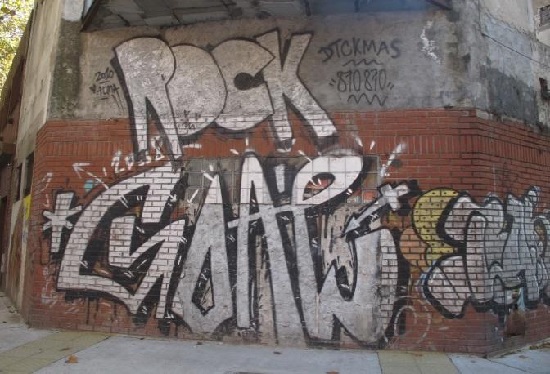
Beyond this one wall there are further examples of conflict and communication that stretch across the corners. As demonstrated in the initial description of the Lemos/Santos Dumont crossroad, there is a high concentration of urban media in this otherwise anonymous part of the neighbourhood. This is likely to be as a response to an initial piece. Melissa from graffitimundo, an organisation based in Buenos Aires that promotes street artists and organises street art tours across the city, suggests that walls opposite works by street artists and muralists are very often tagged by graffiti writers. This stems from some of the most basic principles of graffiti ideology that sprung up in New York in the early 1970s. As Cedar Lewisohn explains, competition and fame-seeking are vital in the act of graffiti writing. Taggers tend to exist in a sphere of other writers, each competing to spread their name, or tag, across as wide an area of the metropolis as possible. Lewisohn describes this community as ‘inward looking’ owing to the ‘complex typographic forms of “wild style” lettering, which were intended to be indecipherable and alien to the general public.’
In congruence with Lewisohn, Drexler and Hames-Garcia suggest ‘While the communication of some information might have been one goal [of graffiti writing], other objectives included the very act of redefining public space, the violation of fascist orderliness, and the exercise of a political will that was prohibited… In violation of the law, its very illegibility announcing its unreasonableness to the dominant public, graffiti communicates its message only to the margins.’
However, despite the typically ‘indecipherable’ nature of the typography seen in Figure 2, the pattern of tags and other works of street art conglomerating around an initial larger mural implies an interaction that transcends traditional ideas of the ‘inward looking’ graffiti writing community.
In the example of the Lemos/Santos Dumont crossroads, one can assume that the stencilled piece of the young man’s face was the initial piece, which drew in other members of the community to both spread their names as graffiti writers as well as to engage in the creation of an alternative urban space. While not an act of direct communication, the growth of the crossroads from an initial piece, through a responding tag, to the visually packed environment that the crossroads is today, is fundamental in creating a space that is democratically owned. The variety of styles and pieces, as well as the implicit interaction between them, tells a story of participative creation in, and of, the community. Bowen argues that ‘the writing on the walls defines the space visually and also conceptually as information spaces that hold layered histories of past performances and the usual chatter of other voices.’ Each of the pieces that is visible on the crossroads is symbolic of such a ‘past performance’. With this reading, one can recognise that the area is embellished with the lives and actions of the individuals who have engaged with that space.
Interestingly, the Lemos/Santos Dumont crossroad also presents examples of more direct communication. Smaller slogans include ‘Por Favor Pintar’, ‘Esta Cara No Me Trauma, Entendes?’ and various football related pieces such as ‘River Capo’, ‘Riber Puto’ and ‘Boca Capo LGC.’ It is these examples which refer to football clubs that provide a further interesting example of social conflicts over space in urban media.
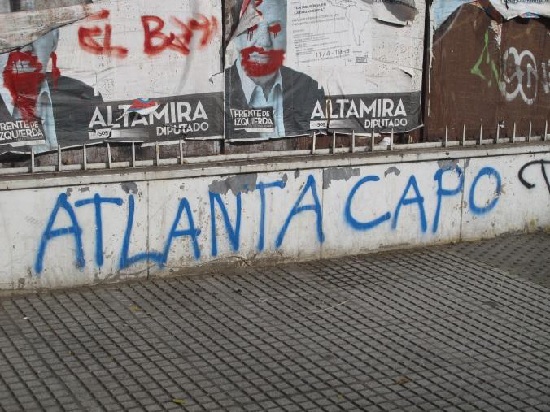
Urban media declaring either an affinity for, or animosity towards, a particular football team are among those most commonly found in the city. Football graffiti comes from a tradition of marking territory which, as Ley and Cybriwsky point out, is as primitive as ‘climbing mountains, descending the ocean depths, landing astronauts on the moon…colonial adventures, riding the freeway, possessing a home on a large lot’ etc. However, these examples are clearly luxuries afforded by those of the middle classes at best, an extreme minority at worst. For the inner-city working class, graffiti and football have both been historically linked with territorialism and the appropriation of urban space. Giulianotti and Armstrong, writing on football hooliganism and urban space, and Ley and Cybriwsky, writing on urban graffiti as territorial markers, note the significance ascribed to territorial ownership within specific urban environments for ‘hooligan formations’ and graffiti crews respectively.
In these two studies one may also recognise a parallel in the demography of the groups involved. Giulianotti and Armstrong observe the prevalence of young, working and lower-middle class members in hooligan groups. Similarly, Ley and Cybriwsky note the high density of graffiti in the working-class neighbourhood of Fairmount in Philadelphia, with the majority of writers being ‘inner city youth’. It therefore seems inevitable that these two forms of urban spatial appropriation, as enacted by young, socially disenfranchised groups should merge into the production of football graffiti.
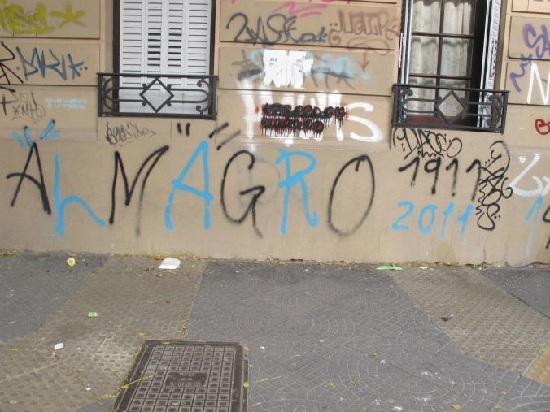
On the walls of Buenos Aires, the city with the highest concentration of football teams in the world, this is an essential aspect of its urban media. Certain neighbourhoods are noted for the domination of a particular team name on its walls, Club Atlético Atlanta in Villa Crespo and Club Almagro in Almagro, for example (Figs. 3 & 4). In the case of the Lemos/Santos Dumont crossroad, the prevalence of ‘Boca LGC’ and ‘Boca Capo’ indicates the use of team names (in this case Boca Juniors) as a combination of territorial marking and tagging-esque competition. As seen in Figure 5, the slogan is repeated numerous times in a small space imposing, or at least attempting to impose, both the domination of that individual tagger, as well as the wider community of Boca fans that the tagger represents, in the surrounding locale. Writing on tags, Andrew Robinson recognises the symbolic importance of ‘tribal names’ in the creation of ‘collective territory’ as an act of resistance to the proper place names and defining tendencies of the legislated city.
This tribal aspect is of clear relevance when considering football slogans on the walls. By appropriating the space for Boca fans the Lemos/Dumont corner becomes a ‘collective territory’ created by a specific social group that ousts the appropriative efforts of another group (in this case the lone ‘River Capo’ tag on the opposite wall does little to counterbalance the territorial claims of the Boca Juniors’ fans dominance).
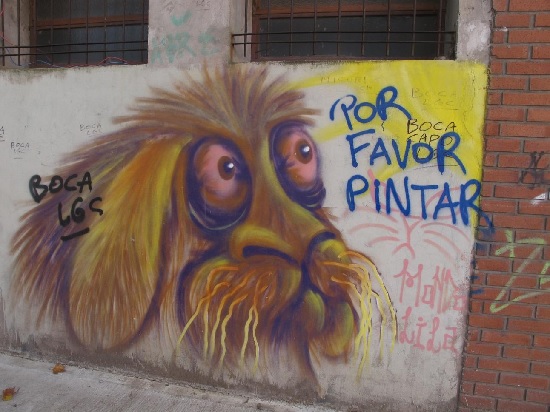
Crucially, the conflict that arises in the process of claiming ownership of a space is demonstrative of the democratising power that engaging with urban media can have. Traditional ideas of ownership and control, such as legal and legislative, are undermined by the very act of claiming the space by the tagger for himself, or in this case, the wider fan body of Boca Juniors. Alison Young draws attention to this idea of ownership in her book on street art and public space in relation to the tagging of trains in New York City, ‘The illicit use of property belonging to another creates for the trespasser…a sense of ownership in another’s property.’ While subversive and technically illegal, the use of urban media to claim space by football fans is an essential declaration of the right to the democratic use and ownership of the city.
...
George Kafka is a freelance writer and founding member of &beyond
Part 2 of this essay will be published in Seismopolite issue 17
[1] Richard Freeman, ‘The City as Mise-En-Scene: A Visual Explration of the Culture of Politics in Buenos Aires’, Visual Anthropology Review, Vol. 17, (Ja, 2008) pp.36-59; Flavio Janches, ‘Significance of Public Space in the Fragmented City: Designing Strategies for Urban Opportunities in Informal Settlements of Buenos Aires City’, United Nations University: World Institute for Development Economics Research, Working Paper No. 2011/13 (March 2011) pp. 1-12. Accessed at http://www.rrojasdatabank.info/wp2011-013.pdf.
[2] Alison Young, Street Art, Public City: Law, Crime and the Urban Imagination, (Abingdon, 2014); Cedar Lewisohn, Street Art, (London, 2008); Luca M. Visconti, John F. Sherry Jr., Stefania Borghini, Laurel Anderson, ‘Street Art, Sweet Art? Reclaiming the “Public” in Public Place’, Journal of Consumer Research, Vol. 37, (October 2010) pp. 511-529.
[3] Don Mitchell, The Right to the City: Social Justice and the Fight for Public Space (New York, 2003) cited from Jules Boykoff and Kaia Sand, Landscapes of Dissent: Guerilla Poetry and Public Space, (Long Beach, 2008) p.25.
[4]Henri Lefebvre, The Production of Space, (Oxford, 1991) p.16.
[5] Sharon Zukin, The Cultures of Cities, (Oxford, 1995). Cited from Anne M. Cronin, Advertising, Commercial Spaces and the Urban, (London, 2010) p.189.
[6] David Harvey, ‘The Right to the City’, New Left Review 53, September-October 2008. Seen at http://newleftreview.org/II/53/david-harvey-the-right-to-the-city
[7] Cynthia Gabbay, ‘El fenómeno posgrafiti en Buenos Aires’, Aisthesis No.54, Dec. 2013. Accessed at http://www.scielo.cl/scielo.php?script=sci_arttext&pid=S0718-71812013000200007
[8] Ken Botnick and Ira Raja, ‘The unruly city: Signs, streets, and democratic spaces’ Thesis Eleven, Vol. 113, (2012). pp 94-111.
[9] Justin Armstrong, ‘The Contested Gallery: Street Art, Ethnography and the Search for Urban Understandings’, AmeriQuests, Vol. 2 (2005).p.3.
[10] Graffitimundo, tour, April 25 2014.
[11] Cedar Lewisohn, Street Art, p. 31.
[12] Jane M. Drexler and Michael Hames-Garcia, ‘Disruption and Democracy: Challenges to Consensus and Communication’, The Good Society, Vol. 13 (2004) p. 59.
[13] Tracey Bowen, ‘Graffiti and Spatializing Practice and Performance’, rhizomes, Issue 25 (2013). Accessed at http://www.rhizomes.net/issue25/bowen/.
[14] David Ley and Roman Cybriwsky, ‘Urban Graffiti as Territorial Markers’, Annals of the Association of American Geographers, Vol. 64 (December 1974), p. 494.
[15] R. Giulianotti and G. Armstrong, ‘’Avenues of contestation: football hooligans running and ruling urban spaces’, Social Anthropology, Vol. 10 (2002) p.219.
[16] The Observer, ’50 sporting things you must do before you die’, Observer Sport Monthly, April 4th 2004. Accessed at http://observer.theguardian.com/osm/story/0,,1182710,00.html
[17] Andrew Robinson, ‘Jean Baudrillard: Strategies of Subversion’, Ceasefire Magazine, September 7th 2012. Accessed at http://ceasefiremagazine.co.uk/in-theory-baudrillard-11/.
[18] Alison Young, Street Art, Public City, p. 136.









